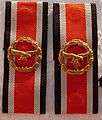Honour Roll Clasp
The Honour Roll Clasp (German: Ehrenblattspange) was a decoration of Nazi Germany during World War II. A total number of 4,556 were awarded to members of the army and Waffen-SS.[1]
| Honour Roll Clasp Ehrenblattspange | |
|---|---|
.jpg) .jpg) .jpg) army, Kriegsmarine and Luftwaffe variants | |
| Awarded by | |
| Country | Nazi Germany |
| Type | Military decoration |
| Eligibility | German armed forces |
| Awarded for | by discretion of German High Command |
| Campaign(s) | World War II |
| Status | Discontinued in 1945 |
| Statistics | |
| Established | 30 January 1944 |
| Total awarded | 4,556[1] |
The Honour Roll Clasp of the army was instituted after the German invasion of the Soviet Union in 1941. Until 30 January 1944, it was only a paper award. After this date, Adolf Hitler introduced the metallic version of the award for the decoration.[1] There were a number of possible qualifications for the Honour Roll Clasp:
- The award could only be bestowed after a recipient had been awarded the Iron Cross in both the First and Second Class.[1]
- To those who "once again (after being awarded the Iron Cross in both classes) distinguished himself in combat".[1]
- Inclusion in the Honour Roll of the German Army (the Ehrenblatt des deutschen Heeres)[1]
There were no specific qualifications to earn this award other than what is mentioned above; its bestowing was at the discretion of the German High Command. It was awarded sparingly to retain a high level of prestige and honour. The Waffen-SS was not legally part of the German Army, but were nevertheless eligible on the same conditions as the army.[1] There were also two variant versions awarded to recipient members of the navy and air force.
Description
 Honour Roll Clasp of the Army[2]
Honour Roll Clasp of the Army[2]
 Kriegsmarine variant[2]
Kriegsmarine variant[2]
The decoration contained a wreath measuring 24.5 mm across, formed of six bunches of Oak Leaves on each side. The width of the wreath was 5 mm at the widest point and tapered to the apex where two oak leaves meet tip-to-tip. The height of the badge from base to tip was 26 mm. The swastika was superimposed upon the separately-made wreath and was soldered onto the wreath assembly. The reverse side had four pins for attachment to allow securing to a strip of Iron Cross Second Class ribbon. This ribbon was then looped through the second button hole on the tunic of the recipient.[3]
Notes
- Angolia 1987, p. 316.
- Angolia 1987, p. 317.
- Angolia 1987, pp. 316, 317.
References
- Angolia, John (1987). For Führer and Fatherland: Military Awards of the Third Reich. R. James Bender Publishing. ISBN 0912138149.CS1 maint: ref=harv (link)